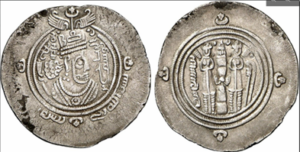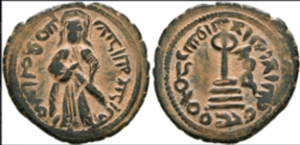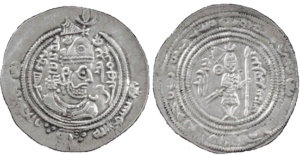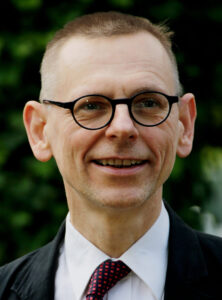
- This event has passed.
The Introduction of Islamic Coinage in 697-98: The before and after
April 5 @ 12:00 pm - 2:00 pm
Free



The Circle for Late Antique and Medieval Studies is pleased to present a panel discussion on:
The Introduction of Islamic Coinage in 697-98: The before and after
What were the stages through which Islamic coinage was established in 697-698 CE? How did the Byzantine & Sasanian coinage transition during this process of change? What were the new Islamic motifs? And why did old coinage survive in the East?
Three distinguished historian/numismatist will discuss these questions:
Stuart D. Sears, Independent Scholar
Stefan Heidemann, Professor of Islamic Studies
Universität Hamburg, Asien Afrika Institut
Michael Bates, Curator Emeritus of Islamic Coins
American Numismatic Society
This panel discussion will take place online only. Please REGISTER VIA ZOOM to participate.
 Stuart Sears is an Arabic translator and independent scholar who writes on numismatics and the social and political thought of the late antique and early medieval Near East. Formerly taught early Islamic history at The American University of Cairo, Winner of the Quadrennial Prize of the Royal Belgium Numismatic Society (1997). Articles include “The Tale of Two Cities: Al-‘Abbasiyya and the Rise of the Aghlabid State,” Festchrift for Michael L. Bates (2020), 259-69; and “The Revolt of b. al-Ḥārith b. Surayj and the Countermarking of Umayyad Dirhams in Early Eighth Century CE Khūrāsān,” in The Lineaments of Islam. Studies in Honor of Fred McGraw Donner. Ed. Paul Cobb. In Islamic History and Civilization. Studies and Texts. Vol. 95. Leiden and Boston: Brill, 2012. 379-405.
Stuart Sears is an Arabic translator and independent scholar who writes on numismatics and the social and political thought of the late antique and early medieval Near East. Formerly taught early Islamic history at The American University of Cairo, Winner of the Quadrennial Prize of the Royal Belgium Numismatic Society (1997). Articles include “The Tale of Two Cities: Al-‘Abbasiyya and the Rise of the Aghlabid State,” Festchrift for Michael L. Bates (2020), 259-69; and “The Revolt of b. al-Ḥārith b. Surayj and the Countermarking of Umayyad Dirhams in Early Eighth Century CE Khūrāsān,” in The Lineaments of Islam. Studies in Honor of Fred McGraw Donner. Ed. Paul Cobb. In Islamic History and Civilization. Studies and Texts. Vol. 95. Leiden and Boston: Brill, 2012. 379-405.
Stuart Sears will present on ” The Politics of Believing: The ‘Standing Caliph’ as Righteous Warrior”. Few coin types of the early Muslims have piqued the interest of modern writers more than the tentatively named “Standing Caliph with Symbol on Steps.” The distinctly Muslim coins appear across Syria at the end of the seventh century CE. Nevertheless, they bear little outward resemblance to the all-epigraphic Reformed coins that follow them. Their obverses bear the standing figure of a caliph or war leader girded with sword and whip. Their reverses have a pillar crowned with an orb on top of three or four steps. This paper argues that the type appeals in its iconography to the same themes as the Reformed type does in its legends. It not only invokes the ruler’s duty to impose right authority but also defines this authority as a form of absolute kingship. These motifs draw on late Antique and Qur’ānic tropes. In this context, the type elucidates the socio-religious legitimation of ‘Abd al-Malik’s government in a manner not previously possible.
 Stefan Heidemann has served, since 2011, as Professor of Islamic Studies at Universität Hamburg, and director of “RomanIslam Center of Comparative Empire and Transcultural Studies” in Hamburg (2020-2025). PI of the ERC Advanced Grant Project “The Early Islamic Empire at Work – The View from the Regions Toward the Center” (2014-2019), and editor-in-chief of the Journal Der Islam. Formerly he served as Associate Curator of Islamic Art at the Metropolitan Museum and as Professor of Islamic History and Material Culture at The Bard Graduate Center, New York. Habilitation at Jena University 2001. PhD at Free University Berlin 1993; Cooperation with German, British, French, and Syrian archaeological missions in al-Raqqa, Damascus, Aleppo, Masyaf, Balkh, Karakorum and other sites.
Stefan Heidemann has served, since 2011, as Professor of Islamic Studies at Universität Hamburg, and director of “RomanIslam Center of Comparative Empire and Transcultural Studies” in Hamburg (2020-2025). PI of the ERC Advanced Grant Project “The Early Islamic Empire at Work – The View from the Regions Toward the Center” (2014-2019), and editor-in-chief of the Journal Der Islam. Formerly he served as Associate Curator of Islamic Art at the Metropolitan Museum and as Professor of Islamic History and Material Culture at The Bard Graduate Center, New York. Habilitation at Jena University 2001. PhD at Free University Berlin 1993; Cooperation with German, British, French, and Syrian archaeological missions in al-Raqqa, Damascus, Aleppo, Masyaf, Balkh, Karakorum and other sites.
Professor Heidemann will speak on ‘Abd al-Malik (r. 685-705) was the architect of the Imperial formula of the Islamic Empire, who gave it its expression. This included the design of the naturally ubiquitous coinage. The transition from the Byzantine cross potent on steps on the gold coinage to a different image or symbol was necessary. The first symbols which were invented to replace the Byzantine cross had only a short-lived success. It was soon replaced by something, which expresses the sovereignty of God in the Empire much more appropriate: the ‘Surat of Pure Faith’ from the Qur’an. To understand this crucial transition at the beginning of the Islamic civilization better this preliminary symbol will be analyzed.
 Michael L. Bates, from Kentucky, was educated at Valley High School, Valley Station, Ky., and at the University of Chicago (A.B., ‘63, Ph.D., ‘75). He joined the American Numismatic Society in September 1970 and was promoted to Curator of Islamic Coins in 1977, retiring in 2005. He was an officer of the International Numismatic Commission, 1979-91; Numismatist, Fustat Excavations, 1978, 1980, 1981-82 (with an American Research Center in Egypt Fellowship); Consultant and Curator, Numismatic Collection, Museum of Islamic Art, Kuwait, 1981-85; Visiting Fellow at Oxford University, UCLA, and the University of Toronto.
Michael L. Bates, from Kentucky, was educated at Valley High School, Valley Station, Ky., and at the University of Chicago (A.B., ‘63, Ph.D., ‘75). He joined the American Numismatic Society in September 1970 and was promoted to Curator of Islamic Coins in 1977, retiring in 2005. He was an officer of the International Numismatic Commission, 1979-91; Numismatist, Fustat Excavations, 1978, 1980, 1981-82 (with an American Research Center in Egypt Fellowship); Consultant and Curator, Numismatic Collection, Museum of Islamic Art, Kuwait, 1981-85; Visiting Fellow at Oxford University, UCLA, and the University of Toronto.
Michael Bates will speak on “Sasanian-Type Coinages after the Introduction of Muslim Arabic Coinage in Iran”. In 697-98 the caliph Abd al Malik and al-Hajjaj, his governor general for the lands of the former Sasanian empire, introduced a coinage of entirely new design, bearing only Islamic religious inscriptions in Arabic and some simple decorative elements, to replace the former Muslim silver coinage that continued the imperial Sasanian design. At least 42 mints have been recorded on dirhams of 79 Hijri, the first full year of issue, including mints outside Iran where no coins had been produced before, and others in the next few years. The quantity of surviving Islamic dirhams is huge. There can be no doubt that the caliph and the governor were serious in their intent to replace the old coinage, depicting a Sasanian emperor and a Zoroastrian fire altar, with a new inscriptional Islamic issue. And yet, plenty of the old coins, including the last issues, still survive today. More surprisingly, old style coins of the eastern mints dated well after the year of the reform are generally common. How could it happen that old style coins continued to be produced after their intended abolition? A first step toward an answer is to find out when and where these various coins were produced, or pretended by their inscriptions to have been produced, in the postreform years. In a century of serious study of these issues, no one has yet attempted to map and date this production. An accurate picture is only beginning to be delineated; the first results will be shown.

